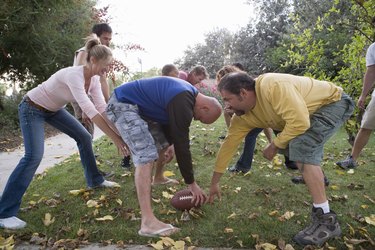
If you had to warm the bench in the months leading up to your baby's birth, you may be eager to resume your pre-pregnancy activities. For optimal health and peak performance, your body has to completely recover from the stresses and traumas of pregnancy and delivery. It's a process that typically takes four to six weeks.
Why It Takes So Long
Video of the Day
While you were pregnant, reduced activity, hormonal changes and a redistribution of body weight caused changes to your muscles and joints. Your abdominal muscles were stretched and weakened, and may have separated. Increased production of the hormone relaxin made your joints more elastic and less stable. An episiotomy or a Cesarean section may have left you with an incision that must heal. All of these changes eventually rectify themselves, but it is a process that takes time.
Video of the Day
Healing and Recovery
Many of the physical changes of pregnancy can persist for four to six weeks postpartum, according to the American Academy of Obstetricians and Gynecologists. If you had a C-section, healing may take up to 12 weeks or longer. Relaxin levels remain elevated into the early recovery period, causing reduced joint stability and increasing your risk of injury. To restore your body to pre-pregnancy condition, ACOG recommends a gradual return to physical activity as soon as it is deemed medically safe.
Getting Back in Shape
Within days after childbirth, the American College of Sports Medicine recommends women perform Kegel contractions, supine pelvic lifts and other exercises geared to tightening the muscles of the pelvic floor. Gradually adding abdominal strengthening exercises and stretches for the lower back muscles will help restore good pelvic alignment and improve core strength. Moderate resistance training exercises for the major muscle groups will help restore joint stability and muscle strength to prepare you for return to play.
Sports and Breastfeeding
Breastfeeding shouldn't impact the time it takes to get back in the game. A 2012 analysis of nursing mothers published in "Pediatrics" asserts that vigorous physical activity coupled with breastfeeding has no adverse physical effects on the mother or the baby. ACOG recommends pumping or nursing immediately before physical activity, then again one hour after exercise. Wear a supportive bra, drink plenty of water, and offset calories burned during exercise by increasing your daily caloric intake to support milk production.
- American College of Obstetricians and Gynecologists: Exercise During Pregnancy and the Postpartum Period
- American College of Sports Medicine: Impact of Physical Activity during Pregnancy and Postpartum on Chronic Disease Risk
- IDEA Health and Fitness Association: Postpartum Exercise
- Pediatrics: Maternal Exercise and Growth in Breastfed Infants: A Meta-analysis of Randomized Controlled Trials
- Ohio State University Medical Center: Exercises After a Cesarian Section